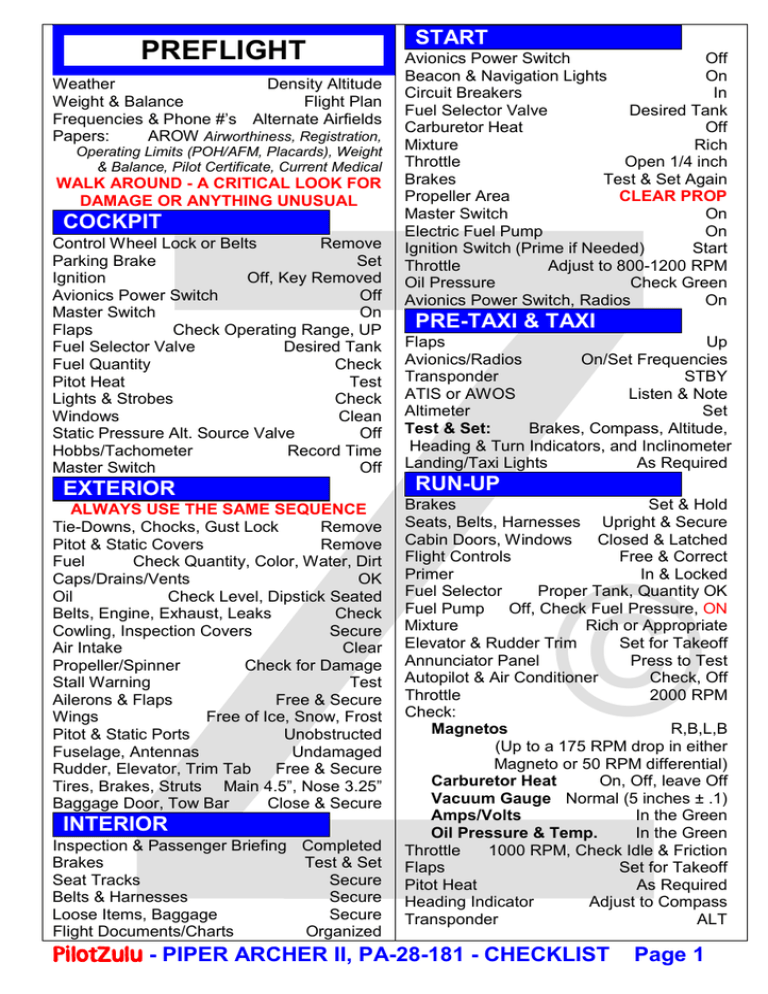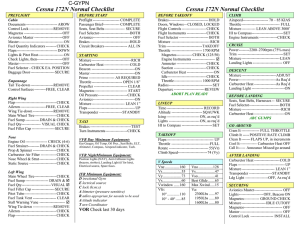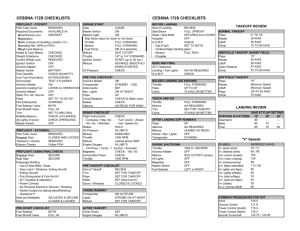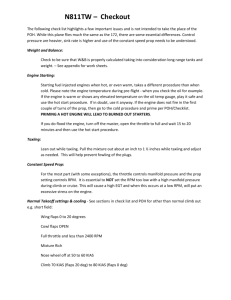
PREFLIGHT
Weather
Density Altitude
Weight & Balance
Flight Plan
Frequencies & Phone #’s Alternate Airfields
Papers:
AROW Airworthiness, Registration,
Operating Limits (POH/AFM, Placards), Weight
& Balance, Pilot Certificate, Current Medical
WALK AROUND - A CRITICAL LOOK FOR
DAMAGE OR ANYTHING UNUSUAL
COCKPIT
Control Wheel Lock or Belts
Remove
Parking Brake
Set
Ignition
Off, Key Removed
Avionics Power Switch
Off
Master Switch
On
Flaps
Check Operating Range, UP
Fuel Selector Valve
Desired Tank
Fuel Quantity
Check
Pitot Heat
Test
Lights & Strobes
Check
Windows
Clean
Static Pressure Alt. Source Valve
Off
Hobbs/Tachometer
Record Time
Master Switch
Off
EXTERIOR
ALWAYS USE THE SAME SEQUENCE
Tie-Downs, Chocks, Gust Lock
Remove
Pitot & Static Covers
Remove
Fuel
Check Quantity, Color, Water, Dirt
Caps/Drains/Vents
OK
Oil
Check Level, Dipstick Seated
Belts, Engine, Exhaust, Leaks
Check
Cowling, Inspection Covers
Secure
Air Intake
Clear
Propeller/Spinner
Check for Damage
Stall Warning
Test
Ailerons & Flaps
Free & Secure
Wings
Free of Ice, Snow, Frost
Pitot & Static Ports
Unobstructed
Fuselage, Antennas
Undamaged
Rudder, Elevator, Trim Tab Free & Secure
Tires, Brakes, Struts Main 4.5”, Nose 3.25”
Baggage Door, Tow Bar
Close & Secure
INTERIOR
Inspection & Passenger Briefing Completed
Brakes
Test & Set
Seat Tracks
Secure
Belts & Harnesses
Secure
Loose Items, Baggage
Secure
Flight Documents/Charts
Organized
START
Avionics Power Switch
Off
Beacon & Navigation Lights
On
Circuit Breakers
In
Fuel Selector Valve
Desired Tank
Carburetor Heat
Off
Mixture
Rich
Throttle
Open 1/4 inch
Brakes
Test & Set Again
Propeller Area
CLEAR PROP
Master Switch
On
Electric Fuel Pump
On
Ignition Switch (Prime if Needed)
Start
Throttle
Adjust to 800-1200 RPM
Oil Pressure
Check Green
Avionics Power Switch, Radios
On
PRE-TAXI & TAXI
Flaps
Up
Avionics/Radios
On/Set Frequencies
Transponder
STBY
ATIS or AWOS
Listen & Note
Altimeter
Set
Test & Set:
Brakes, Compass, Altitude,
Heading & Turn Indicators, and Inclinometer
Landing/Taxi Lights
As Required
RUN-UP
Brakes
Set & Hold
Seats, Belts, Harnesses Upright & Secure
Cabin Doors, Windows
Closed & Latched
Flight Controls
Free & Correct
Primer
In & Locked
Fuel Selector
Proper Tank, Quantity OK
Fuel Pump Off, Check Fuel Pressure, ON
Mixture
Rich or Appropriate
Elevator & Rudder Trim
Set for Takeoff
Annunciator Panel
Press to Test
Autopilot & Air Conditioner
Check, Off
Throttle
2000 RPM
Check:
Magnetos
R,B,L,B
(Up to a 175 RPM drop in either
Magneto or 50 RPM differential)
Carburetor Heat
On, Off, leave Off
Vacuum Gauge Normal (5 inches ± .1)
Amps/Volts
In the Green
Oil Pressure & Temp.
In the Green
Throttle
1000 RPM, Check Idle & Friction
Flaps
Set for Takeoff
Pitot Heat
As Required
Heading Indicator
Adjust to Compass
Transponder
ALT
©
PilotZulu - PIPER ARCHER II, PA-28-181 - CHECKLIST
Page 1
FLIGHT
BE READY TO ABORT TAKEOFF
NORMAL TAKEOFF
Proper Runway
Check Runway Heading
Traffic
Check
Strobes, Landing Light
On when Cleared
Flaps & Trim
Set for Takeoff
Carburetor Heat
Off
Electric Fuel Pump
On, Pressure OK
Mixture
Rich (above 5,000, Lean)
Brakes
Release
Throttle
Full Open
Oil Pressure & Temperature
In the Green
Elevator
Rotate at 52-65 KIAS (60-75)
Vy/Vx
76/64 KIAS (87/74)
Normal Climb Out
76 KIAS (87)
SHORT FIELD
Follow the initial steps from the NORMAL
TAKEOFF checklist above, then:
Flaps
25º
Brakes
Hold & then Release
Throttle
Full Open
Oil Pressure & Temperature
In the Green
Elevator
Rotate 41-49 KIAS (47-56)
Initial Climb Speed
45-54 KIAS (52-62)
Flaps
Retract Slowly at Safe Altitude
CLIMB
Airspeed
76-87 KIAS (87-100)
Throttle
Full Open
Mixture
Rich (above 5,000, Lean)
Engine Instruments
Check
Landing/Taxi Lights
Off
Flight Plan
Call to Open
CRUISE
Power
75% or Less
Elevator & Rudder Trim
Adjust
Mixture
Lean above 5000
Fuel
Change Tanks as Required
Fuel Pump
Off (On when changing Tanks)
Engine & Flight Instruments
Consult
Altimeter
Set QNH
Heading Indicator
Adjust to Compass
DESCENT
Carburetor Heat
On as Required
Power
2500 RPM
Airspeed
122 KIAS (140)
Mixture
Full Rich
ATIS/AWOS
Listen & Note, Set QNH
Wind
Check Direction & Crosswind
LANDING CHECKLIST
Brakes
Pressure in Pedals
Undercarriage
Down & Welded
Mixture, Master, Magnetos Rich, On, Both
Fuel Selector Valve
Proper Tank
Electric Fuel Pump
On
Oil
Pressure & Temperature OK
Hatches & Harnesses
Secure
Seat Backs
Most Upright Position
Carburetor Heat
On
Autopilot & Air Conditioner
Off
Landing/Taxi Lights
On
NORMAL LANDING
Mixture
Full Rich
Electric Fuel Pump
On
Power
As Required
Approach Airspeed 75 KIAS (86) Flaps Up
Flaps
As Required, ≤102 KIAS (117)
Final
66 KIAS (76) (Flaps 40º)
Carburetor Heat
Off AT 200 feet
Brakes
Minimum Required
SHORT FIELD LANDING
Full flaps and enough power to maintain the
desired airspeed and approach flight path.
Reduce speed during flareout and contact
the ground at close to the stalling speed.
Brake while holding nose wheel off ground.
GO AROUND
©
Throttle
Full Open
Carburetor Heat
Off
Electric Fuel Pump
On
Flaps
Retract to 25°
Airspeed
64 KIAS (74)
Flaps
Retract Slowly after 76 KIAS (87)
AFTER LANDING
Flaps ( NO STEP unless flaps up )
Up
Electric Fuel Pump
Off
Landing/Taxi Light
As Required
Strobes
Off
Transponder
STBY
Trim
Takeoff
SHUT DOWN
Parking Brake
Set if Necessary
Avionics/Electrical/All Lights/ELT
Off
Magnetos
Check; R,B,L, B
Mixture
Idle Cut-Off
Ignition Switch & Master Switch
Off
Hobbs/Tachometer
Record
Chocks, Tie Downs, Covers, Doors Secure
Flight Plan
Call to Close
PilotZulu - PIPER ARCHER II, PA-28-181 - CHECKLIST
Page 2
EMERGENCIES
MAINTAIN CONTROL
LOSS OF OIL PRESSURE
HIGH OIL TEMPERATURE
Land Aircraft
As Soon As Possible
Prepare for Power Off Landing
POWER LOSS – TAKEOFF
If sufficient runway remains for a normal
landing, land straight ahead.
If insufficient runway remains, maintain safe
airspeed, make only shallow turns to avoid
obstructions, flaps as situation requires.
If sufficient altitude has been gained to
attempt a restart – maintain safe airspeed:
Fuel Selector Switch to tank containing fuel
Electric Fuel Pump
Check On
Mixture
Check Rich
Carburetor Heat
On
Primer
Locked
If power is not regained, proceed with power
off landing.
POWER LOSS - IN FLIGHT
ATTEMPT RESTART:
Fuel Selector Switch to tank containing fuel
Electric Fuel Pump
On
Mixture
Rich
Carburetor Heat
On
Primer
In & Locked
Master, Magnetos
Check On, Both
Engine Gauges
Check for Cause
If no fuel pressure is indicated,
check tank selector position again
If time permits, turn the ignition switch to L
then to R then back to BOTH. Move the
Throttle and Mixture control levers to different
settings. Try other fuel tanks. Water in the
fuel could take some time to be used up, and
allowing the engine to windmill may restore
power. If power loss is due to water, fuel
pressure indications will be normal.
IF POWER IS RESTORED:
Carburetor Heat
Off
Electric Fuel Pump
Off
IF POWER IS NOT RESTORED - POWER
OFF LANDING:
Airspeed (Best Glide)
76 KIAS (87)
Note Wind
Look for Best Landing Site
Establish Spiral Pattern; try to be at 1000 feet
above field at downwind position.
Radio
Emergency Call
Transponder
Squawk 7700
Passengers
Brief
Approach
66 KIAS (76)
Touchdown at lowest possible airspeed with
full flaps.
When Committed to Landing:
Ignition
Off
Master Switch
Off
Fuel Selector
Off
Mixture
Idle Cut-Off
Seats Upright, Belts, Harnesses
Secure
Doors
Unlatch
LOSS OF FUEL PRESSURE
Electric Fuel Pump
Fuel Selector
On
Check on Full Tank
ENGINE FIRE - START
Starter
Crank Engine
Mixture
Idle Cut-Off
Throttle
Open
Electric Fuel Pump
Off
Fuel Selector
Off
If fire continues for more than a few seconds,
then fire should be extinguished by the best
external means.
©
FIRE IN FLIGHT
ELECTRICAL FIRE (Smoke in Cabin):
Master Switch
Off
Vents
Open
Cabin Heat
Off
Land as soon as practicable
ENGINE FIRE:
Fuel Selector
Off
Throttle
Closed
Mixture
Idle Cut-Off
Electric Fuel Pump
Off
Heater & Defroster
Off
Proceed with power off landing procedure.
PilotZulu - PIPER ARCHER II, PA-28-181 - CHECKLIST
Page 3
ALTERNATOR INOPERATIVE LIGHT:
Ammeter
Check to verify Inop. Alternator
Electrical Load
Reduce
Alternator Circuit Breaker
Check & Reset
Alternator switch (ALT)
Cycle, Off, On
If power is not restored, turn off ALT, leave
Battery (BAT) on.
Battery is the only
remaining source of electrical power.
Reduce electrical loads, land ASAP
AMMETER INDICATES HIGH OUTPUT:
High reading may be caused by a low
battery, or other abnormal electrical load.
If interlocked BAT/ALT switch, turn ALT Off,
use battery only, land ASAP. If separate
BAT/Alt switches, cycle BAT switch. If the
Ammeter reading does not decrease within
five minutes, turn BAT switch Off, use
alternator only and land as soon as possible.
USEFUL DATA
Rate of Climb – Sea Level, Std. ° 730 FPM
Service Ceiling
13650 Feet
Landing - 50’, Sea Level, Std. °
1400 Feet
Landing - Ground Roll
920 Feet
Takeoff - 50’, 25% flaps, SL, Std. ° 1680 Feet
Takeoff - Ground Roll
900 Feet
Maximum Weight (Ramp)
2558 Lbs
Empty Weight (varies/each aircraft) 1600 Lbs
Maximum Useful Load
958 Lbs
Fuel Capacity:
Std 50 USG (48 usable)
24 USG usable, each tank (17 to tabs)
(unusable fuel included in empty weight)
Oil (included in empty aircraft weight) 8 USQ
Fuel Type
100 LL (Blue), 100 (Green)
© 2006 PilotZulu Corporation. Copyright claimed
for Piper Archer II, PA-28-181 Checklist. All rights
reserved. No portion of this material may be
reproduced or transmitted in any form or by any
means without prior permission from PilotZulu
Corporation. All critical flight information must be
verified by the user by reference to the official and
current publications of the applicable government
and of the manufacturers of the aircraft and its
equipment. The main reference for this material is
the Official Archer II, PA-28-181 Information
Manual issued July 2, 1979 and revised through
April 2, 1998. Data contained herein should be
considered approximate and will vary depending
on the model year, age, weight, loading and
upkeep of the particular aircraft and on the
weather, altitude, terrain, and skill of the pilot.
Neither the Corporation nor the authors assume
any responsibility for the use of the material
contained herein.
IMPORTANT SPEEDS
KIAS MPH
Climb, Best Angle
Vx
64
74
Climb, Best Rate
Vy
76
87
Stall (full flaps)
Vso
49
56
Stall (flaps up)
Vsi
55
63
Max Speed, flaps
Vfe
102
117
Max Structural Cruise
Vno
125
144
Maneuvering Speed
Va
2550 lbs
113
130
1634 lbs
89
102
Never Exceed
Vne
154
177
Crosswind Landing (max demo) 17
19
Rotation
52-65 60-75
Enroute Climb
87
100
Best Glide (1.6nm/1000 ft.)
76
87
(Flaps Up, No Wind, Power Off, 2550 Lbs.)
Approach
75
86
Final Approach (full flaps)
66
76
CRUISE PERFORMANCE
Standard Temperature - 59°F/15°C, No Wind
Wheel Fairings Installed, 2550 Lbs.
RPM
% Power KTAS
GPH NMPG
2220
2360
2520
2,000 feet MSL:
55%
97
7.8
65%
110
9.0
75%
119
10.6
12.4
12.2
11.2
2300
2460
2600
6,000 feet MSL:
55%
102
7.8
65%
116
9.0
75%
125
10.6
13.1
12.9
11.8
2380
2540
10,000 feet MSL:
55%
108
7.8
65%
122
9.0
13.9
13.6
©
10,000 feet MSL, Economy
(Mixture leaned to 100º F Rich of Peak EGT)
------*
55%
104
6.3
16.5
------*
65%
119
7.6
15.7
* Not provided in Pilot Operating Handbook
KTAS = Knots True Airspeed
KIAS = Knots Indicated Airspeed
KCAS = Knots Calibrated Airspeed
Rule of Thumb – KIAS to KTAS, add 2%
per 1000’ of altitude.
PilotZulu - Piper Archer II, PA-28-181 - CHECKLIST
Page 4




